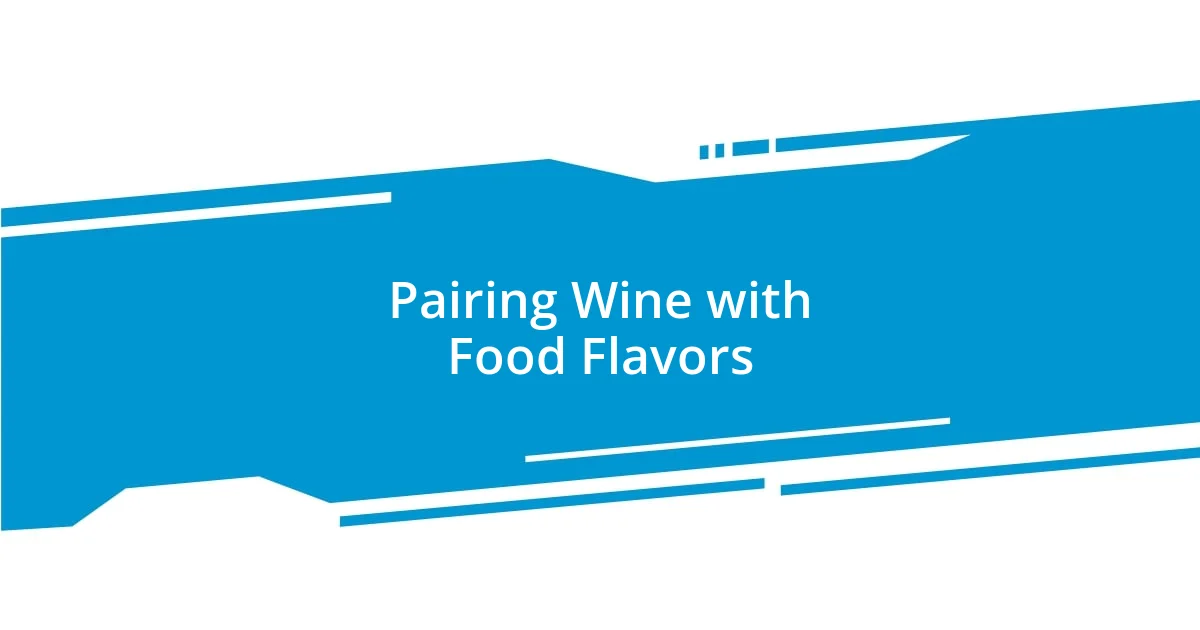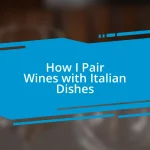Key takeaways:
- Understanding guest preferences enhances wine selection and creates memorable experiences.
- Wine pairings should consider the dinner menu, balancing flavors and textures for optimal enjoyment.
- Presentation, including temperature and storytelling, elevates the overall wine serving experience at dinner parties.

Understanding Guest Preferences
When selecting wines for a dinner party, I always try to tap into what my guests enjoy. For instance, last month, I hosted a soirée where I knew one of my friends adored fruity reds while another preferred crisp whites. It was fun to contrast those choices, and I felt confident serving a luscious Pinot Noir alongside a bright Sauvignon Blanc.
Have you ever asked your guests what wines they prefer? I’ve found that even a simple pre-party text can reveal so much. Just last week, I learned that a new friend I invited has a penchant for oaked Chardonnays, something I hadn’t noticed during earlier conversations. These insights not only help me choose the right bottles but also show my guests that their tastes matter.
Understanding my guests’ preferences often leads to delightful surprises. For example, on one memorable occasion, I brought a unique orange wine that no one had ever tried. Watching their faces light up as they took their first sip was priceless and made the evening even more enjoyable. Don’t you agree that discovering new flavors together creates unforgettable memories?

Assessing the Dinner Menu
When assessing the dinner menu, I always consider the main ingredients and cooking methods used in each dish. For instance, if I know I’ll be serving grilled salmon, I like to pair it with a wine that complements the delicate flavors of the fish. One time, I matched a perfectly seared lemon-garlic herb chicken with a smooth Chardonnay, and it was remarkable how well they complemented each other, making the meal truly memorable.
I’ve learned that contrasting dishes can sometimes call for unexpected wine choices. Picture this: I once had a menu featuring both rich lasagna and a light, herby salad. I decided to serve a medium-bodied red, like a Chianti, alongside a zesty white, such as a Sauvignon Blanc. The delightful interplay of flavors left my guests chatting about the pairings long after the meal was over.
Taking into account the style of the meal is also crucial. If it’s going to be a casual, family-style gathering, I might lean towards wines that are approachable and crowd-pleasers. I recall one evening where I served a mix of hearty comfort food alongside a collection of easy-drinking wines. The laughter and warm atmosphere that filled my home proved that a well-selected wine can enhance the entire dining experience.
| Dish Type | Suggested Wine Pairing |
|---|---|
| Grilled Salmon | Sauvignon Blanc |
| Lasagna | Chianti |
| Garlic Herb Chicken | Chardonnay |
| Herb Salad | Sauvignon Blanc |

Choosing the Right Wine Types
Choosing the right types of wine can feel a bit daunting, but I find it all comes down to balance. Last summer, I had a backyard barbecue where I decided to experiment with wine pairings beyond the usual suspects. I picked a fruity Rosé to go with the grilled shrimp, and to my surprise, it brought out an unexpected freshness that my guests raved about for days. That experience reminded me of how essential it is to consider both the dish and the vibe of the evening when selecting wine.
To help streamline the process, I often create a simplified approach based on the main wine types and their best matches. Keeping it straightforward can relieve some pressure and enhance the fun of selecting wines:
- Red Wines: Pair with grilled meats or rich pasta dishes.
- White Wines: Ideal for seafood, light salads, or poultry.
- Rosé: A versatile choice, great for picnics or lighter fare.
- Sparkling Wines: Perfect for celebrations or spicy dishes.
- Dessert Wines: Complement sweet treats or cheese platters.
By thinking about the overall theme and atmosphere, I’ve learned that choosing the right wine type can not only enhance the meal but also elevate the entire experience. Just recently, I hosted a cozy get-together with a delicious cheese board, and opening a bottle of sparkling wine turned casual nibbles into a joyous celebration. Honestly, there’s something magical about sharing a well-paired wine that brings people together, don’t you think?

Pairing Wine with Food Flavors
When it comes to pairing wine with food flavors, I dive into the texture and taste profiles of both the wine and the dish. Recently, I had a dinner where I served a creamy mushroom risotto, and I knew a full-bodied Pinot Noir would beautifully marry with those earthy, rich flavors. The moment my guests took their first bite with a sip of wine, I could see their smiles; that harmony created an unforgettable experience.
I also believe that the acidity in wine plays a vital role in balancing flavors. At a summer gathering, I prepared a vibrant tomato basil pasta. I instinctively reached for an acidic, crisp Vermentino. The zesty notes of the wine cut through the richness of the sauce, crafting a delightful contrast that lingered in every bite. It’s fascinating how a well-chosen wine can transform a simple dish into something special, isn’t it?
Exploring these pairings often feels like a beautiful dance, where each element brings out the best in the others. I remember hosting a wine and cheese night, and my guests were surprised by how a sweet Riesling paired perfectly with a sharp cheddar. The flavors intertwined in a way that left us all buzzing with excitement. Moments like these remind me that pairing wine isn’t just a formula; it’s about the joy of discovery and the stories we create around the table.

Exploring Regions and Varietals
When I think about exploring different wine regions and varietals, I’m often reminded of a trip I took to Napa Valley. Walking through the vineyards, I relished the unique terroir—the interaction of the soil and climate—shaping the wines. I still remember tasting a luscious Zinfandel right where the grapes were grown; it felt like the very essence of that sun-soaked valley captured in a bottle. It showcased the beauty of selecting a wine that not only pairs well with food but also carries a sense of place and character.
I’ve also grown fond of discovering lesser-known varietals, like Tannat from Uruguay. One evening, I served a robust Tannat alongside a rich beef stew, and the flavors were sublime. My guests were surprised at how beautifully the wine complemented the dish, sparking conversations about the hidden gems found outside the mainstream. Isn’t it thrilling to introduce guests to something unexpected and watch their reactions? For me, moments like that can make the evening truly memorable.
Additionally, I’ve found that exploring wine regions often opens the door to storytelling. At one dinner, I featured a bold Malbec from Argentina, sharing anecdotes from my time in Buenos Aires. As I spoke about the vibrant culture and the passionate winemakers, I noticed my guests leaning in, captivated not only by the wine but also by the narrative behind it. Isn’t wine more than just a beverage—doesn’t it also encapsulate the stories and experiences we share?

Setting a Budget for Wines
Setting a budget for wines is one of the first steps I take when planning a dinner party. I like to determine how many bottles I’ll need based on the guest count, ensuring there’s enough variety. For instance, if I’m expecting six friends, I usually aim for three bottles—maybe a white, a red, and something sparkling. This way, I can cater to different tastes while staying within my budget.
In my experience, it’s crucial to balance quality and cost. Some of my best wine moments came from bottles in the $15 to $30 range. I recall discovering an exceptional Garnacha that completely surprised my guests, who assumed it must have cost far more. It’s moments like that when I realize you don’t need to break the bank to impress—you just need to be a little savvy in your selection.
I always recommend setting aside 10-15% of your overall dinner party budget for wine. This practice has helped me avoid overspending while still ensuring a memorable experience. While I love splurging occasionally, I exactly love when my guests ask for seconds on a wine I snagged on sale. Have you ever found a hidden wine gem that blew everyone away? For me, that’s the thrill of wine selection—finding quality without the hefty price tag.

Presentation Tips for Serving Wine
When it comes to serving wine at a dinner party, presentation can elevate the entire experience. I remember the time I brought out a bottle of Cabernet Sauvignon in a beautifully decanter, pouring it into crystal glasses. The way that deep red liquid swirled and caught the light made my guests’ eyes widen with anticipation. Isn’t it amazing how the right presentation can set the tone for the evening?
I also believe that the temperature of wine is crucial. I once served a lovely white wine straight from the fridge, only to realize it was a tad too cold to appreciate its floral notes. Since then, I’ve made it a habit to let whites sit for a few minutes outside the fridge before serving and to decant reds slightly ahead of time. Have you ever noticed how a wine’s flavors come alive at the right temperature? It’s a little detail that can make a big difference.
Finally, I like to create a little mystique around the wine by sharing its background as I serve it. For instance, when pouring a delicate Pinot Noir, I often mention its origin from a small vineyard I visited. The look on my guests’ faces as they take their first sip, knowing it comes from a place I’ve experienced, is priceless. Doesn’t that personal touch make the wine more memorable? It’s those small stories that can weave connections among us, enhancing the enjoyment of both the wine and the company.
















